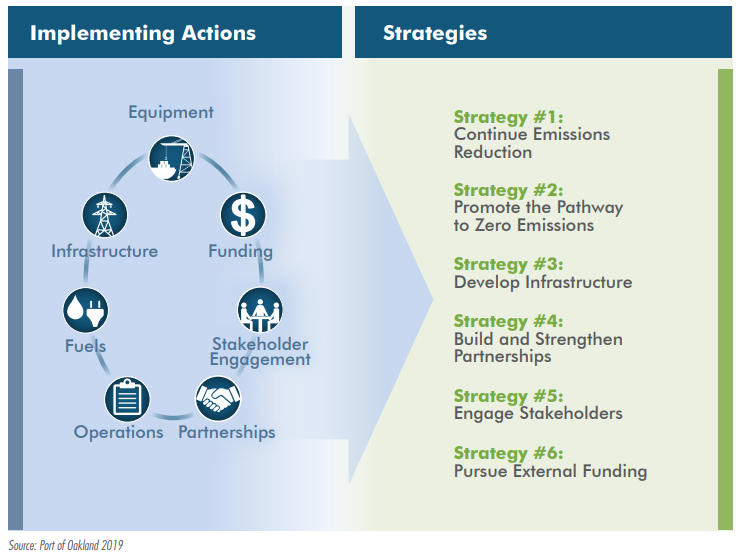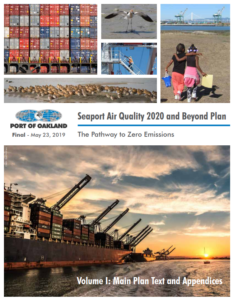The US Port of Oakland has approved an air quality plan intended to drastically cut diesel and greenhouse gas emissions resulting from the port’s maritime operations. The plan, called the Seaport Air Quality 2020 and Beyond Plan, envisions a zero-emissions operation in the future.
The Oakland Board of Port Commissioners voted last week to approve the 259-page plan.
The Port said that the plan would provide a framework for maritime development for the next 30 years.
The plan calls for changes in equipment, operations, fuels and infrastructure at the seaport.
Key projects outlined in the plan:
-Strategy #1: Continue Emissions Reduction Programs and Projects
Examples of Implementing Actions that support Strategy #1 include:
- Convert a portion of the Port’s fleet to battery-electric vehicles.
- Use renewable diesel in the Port’s diesel-powered equipment.
- Retrofit rubber-tired gantry (RTG) cranes to hybrid equipment.
- Adopt voluntary or incentivized vessel speed reduction.
-Strategy #2: Promote the Pathway to Zero Emissions Equipment and Operations
Examples of Implementing Actions that support Strategy #2 include:
- Conduct engineering and operational feasibility studies for zero-emissions cargo-handling equipment (CHE).
- Implement the use of renewable diesel for the Port vehicle fleet.
- Develop battery-electric equipment demonstration projects funded by grants and/or equipment manufacturer
-Strategy #3: Develop Infrastructure to Support the Pathway to Zero Emissions
Examples of Implementing Actions that support Strategy #3 include:
- Develop a guide for electric vehicle charging infrastructure projects in the Seaport Area.
- Perform engineering feasibility studies for container terminal electrification.
- Expand the electrical charging infrastructure for the Port’s vehicle fleet.
- Track the development of uniform charging standards for zero-emissions equipment, and advocate for Port-specific needs.
- Conduct feasibility studies for other alternative fuels, such as hydrogen fuel cells.

-Strategy #4: Build and Strengthen Partnerships
Examples of Implementing Actions that support Strategy #4 include:
- Continue to participate in working groups, such as the Trucker Working Group and the Port Efficiency Task Force (PETF).
- Conduct regular meetings with tenants as well as shipping lines and other customers.
- Collaborate with regulatory, resource and public health agencies.
- Partner with other ports on grant applications.
- Advocate for cleaner OGVs and fuels
-Strategy #5: Engage Stakeholders
Examples of Implementing Actions that support Strategy #5 include:
- Conduct regular Task Force meetings.
- Hold Community Town Hall meetings.
- Engage stakeholders in the development of the Plan Update in 2023.
- Coordinate with Task Force Co-Chairs to conduct Working Sessions regarding topics of interest to stakeholders.
-Strategy #6: Pursue External Funding
Examples of Implementing Actions that support Strategy #6 include
- Track the websites of the California Air Resources Board (CARB), California Energy Commission (CEC), and BAAQMD for information on upcoming grant and incentive funding programs, and develop a thorough understanding of each grant and incentive program’s requirements.
- Advocate for new or expanded State and federal grant opportunities.
- Collaborate with tenants to pursue grant funding for specific projects.
The Seaport Air Quality 2020 and Beyond plan is the successor to Oakland’s Maritime Air Quality Plan adopted a decade ago.
That plan helped the Port reduce diesel particulate matter by 81%. Truck diesel emissions were down 98% and ship emissions dropped 78%.
The Port’s Seaport Air Quality 2020 and Beyond Plan sends a powerful message that the Port will lead the way towards a post-carbon future. We’re always looking at pollution reduction measures that reflect new technologies, financial resources and stakeholder input,
…said Port of Oakland Executive Director Chris Lytle.
Explore more herebelow:
































































